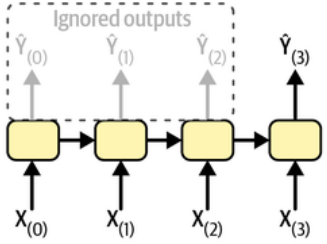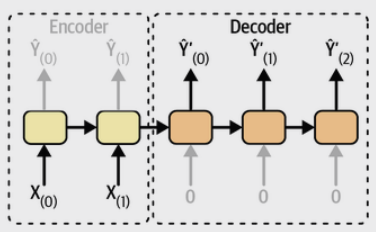Recurrent Neural Network Topologies (or The Types of RNN)¶

- red box : input layer
- blue box : hidden layer
- orange box : output layer
RNN에서는 위의 box를cell이라고도 칭함.
참고 : topology란?
one-to-one¶
vector-to-vector라고도 불림.
여기서one이란 time-step의 관점에서 하나의 element 임을 의미.
입력과 출력이 각각 single time-step에 해당하는 vector (or scalar)임.
사실 RNN에서 가장 단순한 구조로 ***단일 memory cell***로 만들어지며 실제로 사용되는 경우는 거의 없음.
- ref. : memory cell
one-to-many¶
vector-to-sequence라고도 불림.
하나의 image가 들어가서 해당 image에 대한 caption이 생성되는 image captioning task에서 사용되는 network를 생각하면 이해가 쉽다.
single time-step의 input에 대해 sequence output이 나오는 network임.
feature vector를 입력받는 text generation model이라고 봐도 됨.
many to one¶
sequence-to-vector라고도 불림.
앞서 다룬 one to many의 반대에 해당한다. RNN을 소개할 때 많이 사용되는 sentiment analysis network 가 대표적인 예이다.
5만개의 IMDb reviews (영화리뷰)에 대해 negative review인지 positive review인지를 판별하는 sentiment analysis network는 RNN분야에서의 hello world에 해당하는 예제임.
- IMDb : Internet Movie Database : goto site
실제 구현할 때는 아래 그림처럼 각 RNN cell에서 마지막 출력 외에는 무시하는 형태로 구현됨.

many to many (encoder-decoder)¶
sequence-to-sequence의 일종이지만,encoder-decoder로 더 많이 불림 (seq2seq로 불림).
왼쪽의 input sequence (3 time-steps)들이 존재하는 부분은 encoder라고 볼 수 있고, 이후 오른쪽의 output sequence가 있는 부분을 decoder라고 볼 수 있음.
input sequence를 전체를 입력받아서 encoding을 수행하여 represent(=context vector)를 얻고 이를 기반으로 decoding을 하여 output sequence를 얻는 형태로 2017년 transformer가 등장하기 전까지 machine translation 분야 등에서 인기있던 topology였음.
위의 그림과 같이 encoder와 decoder가 연결된 가운데에서 input과 output이 같이 존재하는 형태로 그려지기도 하지만, 아래 그림처럼 input seq.가 있는 곳에선 output이 없고, output이 있는 곳에선 input이 없는 형태로 그려지기도 함.
이경우
many-to-one과one-to-many가 연결된 것으로도 볼 수 있다.
many-to-many¶
오른쪽에서 끝에 놓인 many-to-many는 time sequence를 forecast하는 경우 등에 애용된다.
앞서본 encoder-decoder와 달리 input sequence의 모든 time step을 끝까지 기다릴 필요없다는 장점을 가진다 (최근 N개의 time step 데이터를 바탕으로 forecast를 수행).
이는 causal system이라는 가정이 깔려있다고도 볼 수 있음.
참고 : Causal System이란
